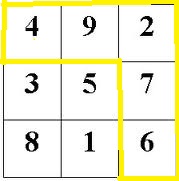 Considered to be one of the great, 8th century alchemists, Jabir ibn Hayyan (also known as Geber) held the 3×3 magic square with the highest esteem. This numerical grid contains the numbers 1 thru 9, in such a way, that the sum of every row, column, and diagonal, render the magic constant of 15.
Considered to be one of the great, 8th century alchemists, Jabir ibn Hayyan (also known as Geber) held the 3×3 magic square with the highest esteem. This numerical grid contains the numbers 1 thru 9, in such a way, that the sum of every row, column, and diagonal, render the magic constant of 15.
Geber believed numbers established within the 3×3 magic square represented the foundation of all matter. In his Method of Balance in Nature, the numbers 1, 3, 5, 8, 17, and 28 were assessed in the square by Geber, and signified immense importance. This belief of the 3×3 magic square providing wisdom is not one only thought by Geber. Although called the Lo Shu, the same numerical square exposed and symbolized balance for ancient China, as well. The Lo Shu magic square was used to formulate the sacred practice of the I Ching and is a system which is still respected today.
For Geber, the number 17 was particularly valued and was revealed through the contemplation of the magic square. The numbers 1, 3, 5, and 8 of the magic square are found within the bottom, left corner cells. They are considered the seed to creation by Jabirian alchemists. According to Geber’s method, the numbers were associated with the four elements; 1=fire, 3=earth 5=water, and 8=air (or natures of hot, cold, wet, and dry). Together, their sum present the number 17.
 The number 28 (the last of Geber’s key numbers), is calculated by summing the Gnomon or the remaining numbers of the magic square; 4, 9, 2, 7, and 6. Twenty-eight is recognized as the second perfect number. Perfect numbers are defined as numbers which the sum of their divisors equals themselves (not including). So for instance, the divisors of 28 are 1,2,4,7, and 14 and add to 28. The first perfect number is 6. It is interesting to note the difference of the first two perfect numbers is 22. Twenty-two is found to hold importance by many. One such example is it is the number of letters in the Hebrew alphabet which relates to the Tree of Life and the Tarot.
The number 28 (the last of Geber’s key numbers), is calculated by summing the Gnomon or the remaining numbers of the magic square; 4, 9, 2, 7, and 6. Twenty-eight is recognized as the second perfect number. Perfect numbers are defined as numbers which the sum of their divisors equals themselves (not including). So for instance, the divisors of 28 are 1,2,4,7, and 14 and add to 28. The first perfect number is 6. It is interesting to note the difference of the first two perfect numbers is 22. Twenty-two is found to hold importance by many. One such example is it is the number of letters in the Hebrew alphabet which relates to the Tree of Life and the Tarot.
The history for the term Gnomon, which is used to describe the shape which remains after the smaller square from a corner is removed, is an intriguing one. It is the ancient Greek word which implies ‘that which knows.’ The gnomon ‘knows’ the smaller square even though it is not there. The L shape of the gnomon contains all the necessary information to know the missing section, and in turn, to become whole.
First applied to the object which casts the shadow on a sundial, a Gnomon was considered ‘the knower of time.’ Also, because of its L shape, it came to refer to the square used by masons to determine right angles.
What I find interesting is the relationship of a gnomon to the number 17 shown within the magic square with the common occurrence of the number 17 involving transformation. Those who have researched the popular 14th century alchemist, Nicolas Flamel, most likely recall, it was on the 17th of January in which Flamel was believed to have transmuted base elements into Gold. It would seem Geber’s regard for 17 may have influenced this date to become so prevalent in relation to changing states.
This may even cause one to wonder about a hidden and deeper meaning to the Mason’s square (also called a Gnomon). This devise, used to determine right angles, seems to know how to complete itself. In connection to the magic square, the gnomon completes itself by ‘knowing 17.’
As Geber felt the corner (represented by 17), was the basis for creation, is it a stretch to say the gnomon knows ‘what gives life?’ In a previous article, The Hidden Meaning of Number 17, seventeen was seen associated to the Vesica Piscis. Within the shape of connecting worlds (the Vesica Piscis), the Truth, the Way, and the Life(as Christ), is often depicted. The gnomon knows time; the beginning and the end. The number 17 is like a cornerstone which provides a foundation for the whole.
The magic square has always been an object of contemplation since first discovered, and it would seem, it will continue to be so.
